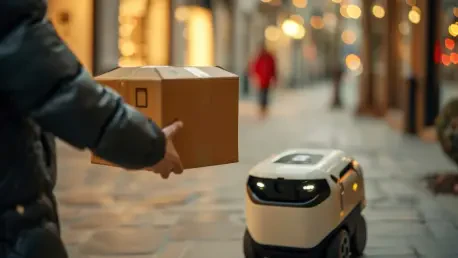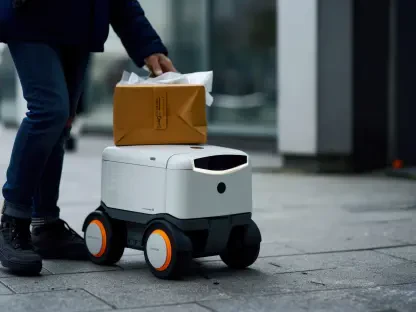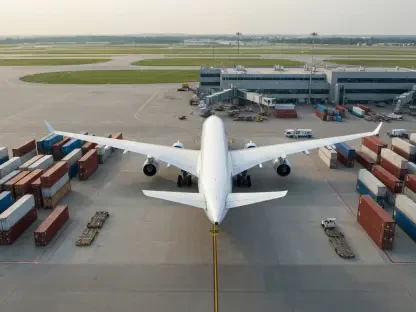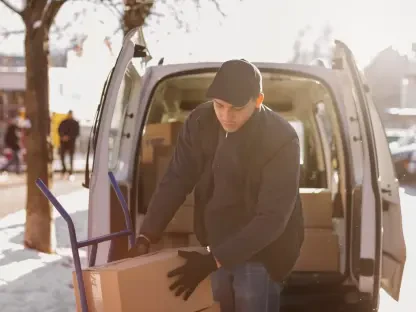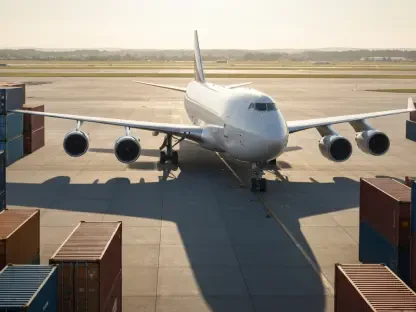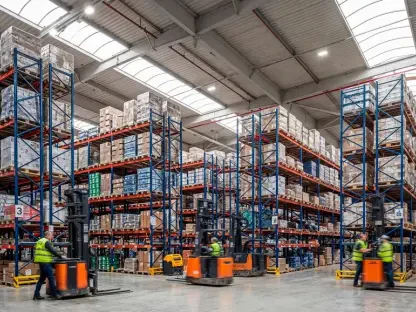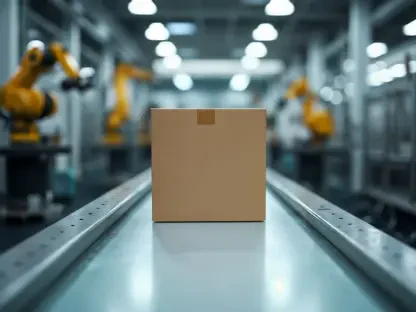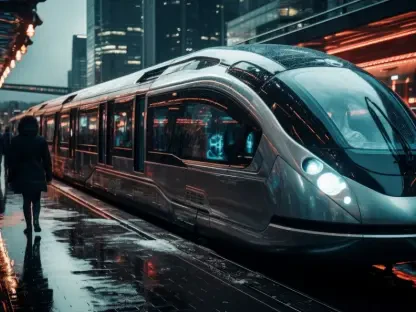Rohit Laila, with decades of experience in logistics and a passion for technological advancements in the sector, is at the forefront of transforming last-mile delivery systems. As the global demand for efficient urban logistics grows, his insights into the partnership between FedEx and QuikBot are invaluable. This collaboration is pushing boundaries in smart logistics by utilizing autonomous delivery robots integrated with cutting-edge AI. In this engaging interview, we explore how this alliance is poised to revolutionize urban environments while aligning with sustainability goals.
Can you give us an overview of the partnership between FedEx and QuikBot? How did it come about?
The partnership between FedEx and QuikBot originated from a mutual vision to revolutionize urban logistics and reduce inefficiencies in last-mile delivery. With the increasing complexity of urban environments, it became evident that traditional delivery methods couldn’t keep up. By combining FedEx’s operational expertise with QuikBot’s advanced robotics and AI technology, we aimed to create a more seamless and efficient delivery system that also adheres to environmental and social governance principles.
What exactly is the Agentic-AI platform, and how does it enable autonomous navigation for QuikBot robots?
Agentic-AI is pivotal to our innovation. It equips QuikBot robots with the capability to autonomously traverse complex environments like elevators, parking garages, and indoor spaces. This platform utilizes sophisticated algorithms to allow these robots to make navigational decisions in real-time, ensuring precise deliveries without human intervention. It opens the door to automating tasks previously considered too intricate for machines, significantly enhancing operational efficiency and reliability.
Can you explain the roles of the QuikCat and QuikFox models in the delivery process?
QuikCat and QuikFox are specialized models tailored to different types of deliveries. The QuikCat focuses on short-range, floor-to-floor deliveries within a single building, making it ideal for high-density environments. QuikFox, on the other hand, is designed for mid-range deliveries within a 1.5km radius, efficiently managing transfers between nearby buildings. Together, they form a comprehensive logistics solution capable of handling diverse delivery scenarios with agility and precision.
How do these autonomous robots integrate with existing smart building systems, like those from KONE and Mitsubishi?
Integration with existing smart building systems is crucial for the seamless operation of our robots. QuikBot’s technology synchronizes with systems from companies like KONE and Mitsubishi, ensuring smooth navigation through elevators and other automated infrastructure. This alignment reduces wait times and enhances delivery speed, allowing our robots to maintain a high level of efficiency and integrate effortlessly into the urban landscape.
What have been the outcomes of the pilot tests in Singapore’s South Beach Tower and Mapletree Business City?
The pilot tests in Singapore’s commercial hubs demonstrated remarkable efficiency and effectiveness. We witnessed a reduction of delivery times by approximately 30%, which is a significant milestone. The autonomous operations in these zones were carried out with zero manual interventions, proving the robots’ capability to function independently in busy and complex urban environments. This success paves the way for broader implementation and scalability.
The article mentions a reduced delivery time of 30%—how was this achieved?
This reduction was accomplished by minimizing common delays associated with traditional delivery processes. By deploying autonomous robots that can bypass physical barriers like security checkpoints and elevator queues, we expedited the delivery process. The integration with smart building systems further streamlined operations, allowing couriers to focus on more critical tasks, enhancing overall efficiency.
In what ways does this partnership address labor shortages in urban areas?
By automating repetitive delivery tasks, these robots alleviate the pressure on urban workforces, which are often overstretched. This partnership provides a technological solution to labor shortages, enabling human workers to engage in roles that require higher skills and creativity, while robots handle the routine, time-consuming deliveries around the clock.
How significant is the reduction in carbon footprint when using these delivery robots compared to traditional methods?
The environmental impact is substantial, with emissions cut by up to 40% compared to conventional delivery vans. Our robot fleet is electrically powered, ensuring minimal environmental degradation. This reduction is crucial in supporting urban climate goals and resonates well with our commitment to sustainability and cleaner logistics practices.
What makes the modular design of QuikCat and QuikFox suitable for rapid deployment in cities worldwide?
The modular construction of our robots allows quick adaptation to different urban infrastructures. This feature is particularly advantageous for rapid scaling in diverse environments. Cities equipped with smart infrastructure benefit from this flexibility, facilitating seamless integration and operational startup, which is essential for global expansion.
How does QuikBot ensure compliance with global data privacy standards, like GDPR?
QuikBot adheres to stringent data privacy standards, including GDPR, by implementing robust security protocols and governance structures. Our systems are designed to safeguard data integrity and confidentiality, ensuring compliance with international privacy regulations. This focus on data protection is crucial for maintaining trust and smooth operation within various regulatory landscapes.
What unique governance structures are in place to maintain seamless integration with FedEx’s supply chain?
Our governance structures are crafted to align with FedEx’s expansive supply chain, facilitating interoperability and reducing friction in operations. These structures encompass data management, compliance with global standards, and continuous system updates, ensuring our technology remains compatible and seamlessly integrated with existing FedEx processes and infrastructure.
How are the AI-driven robots supporting climate goals in the Asia-Pacific region?
In the Asia-Pacific region, where urbanization and e-commerce demand drive exponential growth, QuikBot’s robots actively contribute by optimizing delivery routes and reducing congestion. This leads to decreased fuel consumption and emissions, directly aligning with regional climate objectives and helping cities meet ambitious environmental targets.
What specific social risks are mitigated by the ability of these robots to work 24/7?
The capability of these robots to operate continuously addresses social risks such as workforce volatility and labor disputes. It offers a stable logistical solution that accommodates fluctuating demand without the need for overtime or additional shifts, supporting resilience in urban societies and safeguarding against workforce instability.
What gives QuikBot a first-mover advantage in the smart logistics market?
QuikBot’s early achievements in implementing autonomous delivery solutions grant a formidable first-mover advantage. Pioneering developments in Singapore’s commercial zones have established a competitive edge, enabling us to capture key market segments and shaping industry standards with proven technology.
Can you share any details about QuikBot’s expansion plans into Japan, UAE, and Australia?
Our expansion strategy is focused on deploying the robots in cities where smart infrastructure is already established. Japan, UAE, and Australia provide ideal conditions for scaling our operations by year-end 2025. This international rollout aligns with our vision to capitalize on smart logistics trends globally, demonstrating the versatility and readiness of our technology.
How does FedEx’s operational focus on sustainability attract ESG-focused investments?
FedEx’s commitment to sustainability, evidenced by partnerships like ours, appeals to ESG-focused investors keen on supporting environmentally responsible operations. By embedding sustainable practices into core strategies, FedEx enhances its attractiveness to investors prioritizing environmental, social, and governance criteria, which is increasingly decisive in capital allocation.
What are some of the risks associated with the FedEx-QuikBot model, particularly regarding interoperability?
Despite our successes, interoperability remains a challenge, especially with legacy systems requiring upgrades for compatibility. These adjustments can be costly and complex, necessitating careful planning and execution to maintain seamless operations across diverse urban infrastructures.
What regulatory challenges might cities face in adopting autonomous delivery robots?
Cities must navigate regulatory hurdles such as updating zoning laws to permit robot operations on sidewalks and elevators. These changes demand time and comprehensive risk assessments to ensure safety and compliance, posing a significant challenge in adapting to autonomous delivery technologies.
How might cybersecurity risks evolve as autonomous systems like QuikBot become more complex?
As these systems grow in complexity, cybersecurity threats will inevitably evolve. The risk of data breaches increases, requiring continual enhancements to security protocols. Adopting proactive measures and advanced encryption technologies is essential to safeguarding sensitive data and maintaining system integrity.
In what ways do you see the FedEx-QuikBot partnership shaping the future of urban logistics?
This partnership is setting a new standard for urban logistics by demonstrating the potential of AI and robotics to overcome existing challenges. The model provides a blueprint for efficient, scalable delivery systems that align with environmental and social goals. I see it driving innovations that will redefine connectivity and efficiency in cities worldwide, transforming them into smarter urban landscapes.
